Located in Russia, Lake Baikal is a clear and mesmerizing freshwater lake known by natives as the ‘Blue Eye of Siberia’. It is also the largest lake in Russia, containing 5,670 cubic miles of water. It has a surface area of 12,248 square miles, making it the largest freshwater lake in the world by volume! It is also more than ten times the size of Rhode Island’s.
This article looks at Lake Baikal, the world’s largest lake from another angle; its wildlife! Discover what animals live in and near the world’s deepest lake.
Lake Baikal
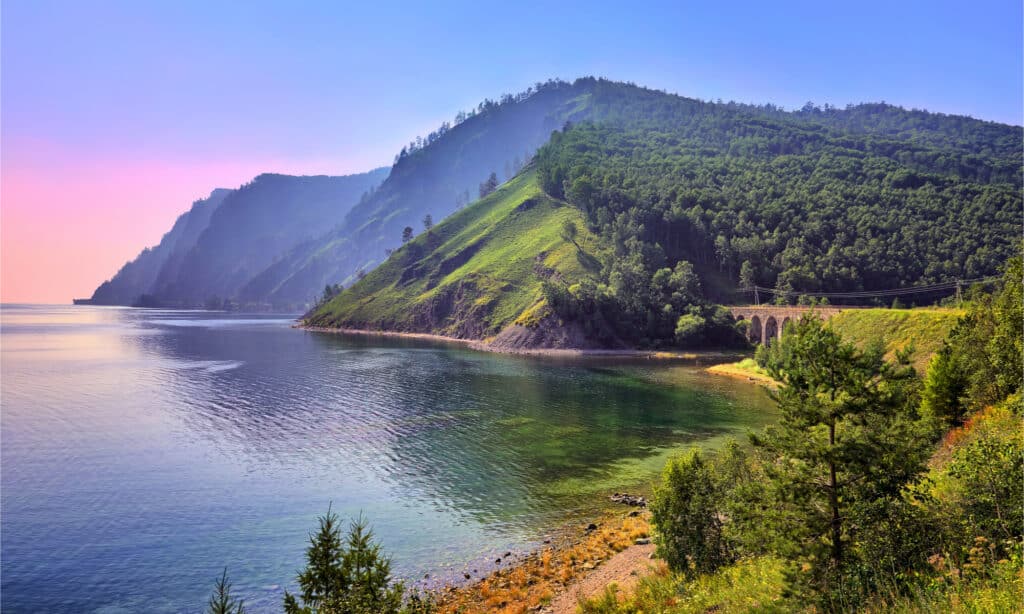
Also known as the ‘Blue Eye of Siberia’, Lake Baikal is the deepest lake in Russia.
©Nikitin Victor/Shutterstock.com
Lake Baikal is often referred to as the oldest lake in the world. It is a gorgeous lake known for ice-skating and dog sledding. During the winter months in Russia- especially January – the lake freezes. When this happens, you can clearly see 40 meters into the water.
As you might imagine, the lake’s depth hints at a robust marine life. However, Lake Baikal has more than just marine animals. Here is a detailed look at the animals that live in and near the world’s deepest lake.
Animals in Lake Baikal
According to iNaturalist, a joint initiative of the California Academy of Sciences and the National Geographic Society, there are 423 animal species in Lake Baikal, 369 of which are confirmed. Here is a comprehensive list of Lake Baikal’s mammals, birds, fishes, amphibians, and reptiles.
Mammals of Lake Baikal
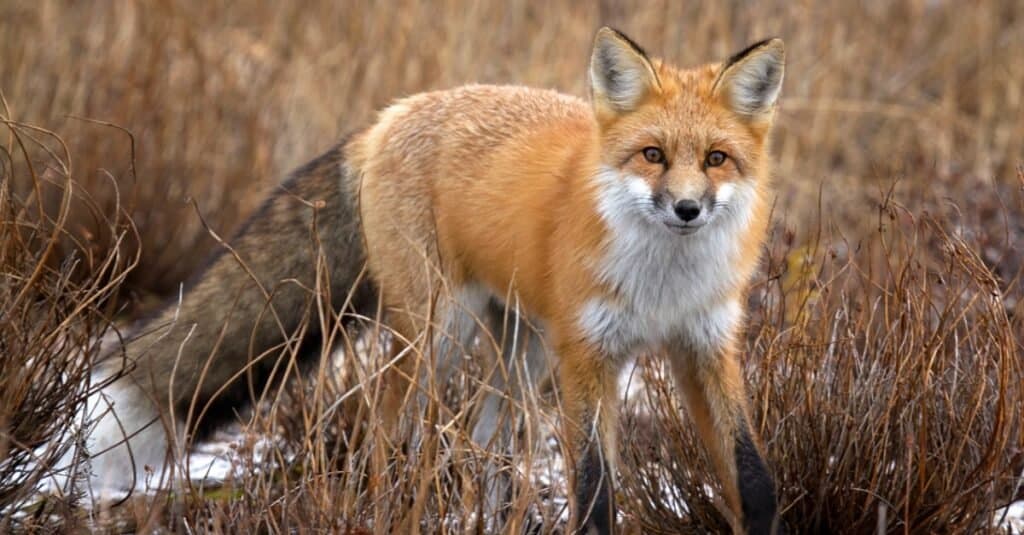
The red fox lives around Lake Baikal.
©iStock.com/Lynn_Bystrom
Lake Baikal is home to more than 15 mammal species.
- American Mink (Neogale vison)
- Asian Badger (Meles leucurus)
- Baikal Seal (Pusa sibirica)
- Brown Bear (Ursus arctos)
- Common Shrew (Sorex araneus)
- Domestic Cow (Bos taurus)
- Eastern Water Bat (Myotis petax)
- Eurasian Red Squirrel (Sciurus vulgaris)
- Long-tailed Ground Squirrel (Urocitellus undulatus)
- Muskrat (Ondatra zibethicus)
- Red Fox (Vulpes vulpes)
- Siberian Bat (Myotis sibiricus)
- Siberian Chipmunk (Eutamias sibiricus)
- Siberian Flying Squirrel (Pteromys volans)
- Tundra Vole (Alexandromys oeconomus)
Birds of Lake Baikal
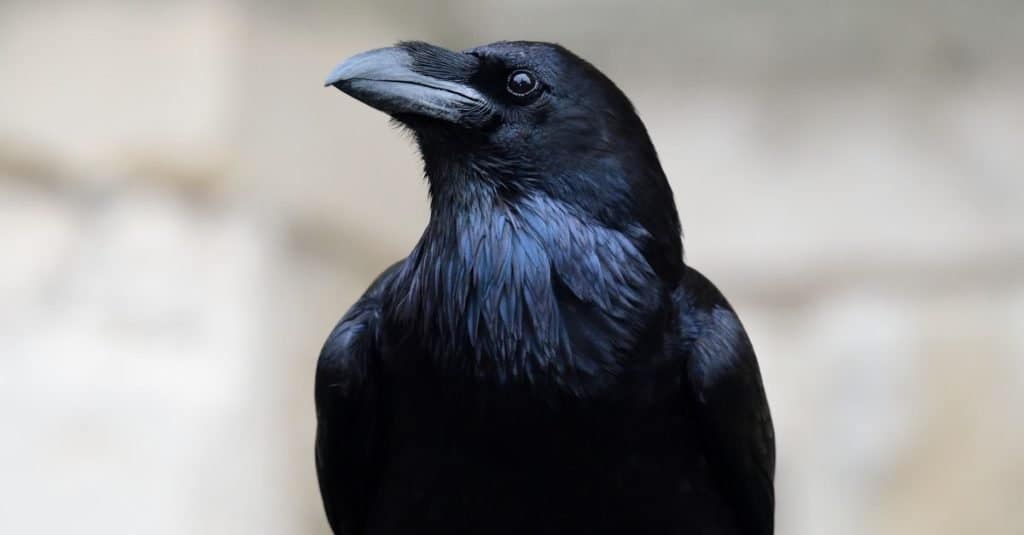
The common raven lives near Lake Baikal.
©iStock.com/Tom Meaker
Lake Baikal is home to almost 199 species of birds. Here are some of the most commonly spotted birds that live near the lake.
- Arctic Warbler (Phylloscopus borealis)
- Asian Brown Flycatcher (Muscicapa dauurica)
- Azure-winged Magpie (Cyanopica cyanus)
- Baikal Teal (Sibirionetta formosa)
- Bank Swallow (Riparia riparia)
- Barn Swallow (Hirundo rustica)
- Black Kite (Milvus migrans)
- Black Stork (Ciconia nigra)
- Black Woodpecker (Dryocopus martius)
- Black-bellied Plover (Pluvialis squatarola)
- Black-faced Bunting (Emberiza spodocephala)
- Black-headed Gull (Chroicocephalus ridibundus)
- Blyth’s Pipit (Anthus godlewskii)
- Booted Eagle (Hieraaetus pennatus)
- Brambling (Fringilla montifringilla)
- Broad-billed Sandpiper (Calidris falcinellus)
- Brown Shrike (Lanius cristatus)
- Carrion Crow (Corvus corone)
- Caspian Tern (Hydroprogne caspia)
- Chestnut Bunting (Emberiza rutila)
- Citrine Wagtail (Motacilla citreola)
- Coal Tit (Periparus ater)
- Common Chaffinch (Fringilla coelebs)
- Common Cuckoo (Cuculus canorus)
- Common Goldeneye (Bucephala clangula)
- Common Greenshank (Tringa nebularia)
- Common House Martin (Delichon urbicum)
- Common Merganser (Mergus merganser)
- Common Raven (Corvus corax)
- Common Ringed Plover (Charadrius hiaticula)
- Common Rosefinch (Carpodacus erythrinus)
- Common Sandpiper (Actitis hypoleucos)
- Common Snipe (Gallinago gallinago)
- Common Whitethroat (Curruca communis)
- Corn Crake (Crex crex)
- Dark-sided Flycatcher (Muscicapa sibirica)
- Daurian Jackdaw (Corvus dauuricus)
- Daurian Partridge (Perdix dauurica)
- Daurian Redstart (Phoenicurus auroreus)
- Demoiselle Crane (Anthropoides virgo)
- Dunlin (Calidris alpina)
- Dusky Warbler (Phylloscopus fuscatus)
- Eastern Buzzard (Buteo japonicus)
- Eastern Marsh-Harrier (Circus spilonotus)
- Eastern Yellow Wagtail (Motacilla tschutschensis)
- Eurasian Bullfinch (Pyrrhula pyrrhula)
- Eurasian Hobby (Falco subbuteo)
- Eurasian Jay (Garrulus glandarius)
- Eurasian Nuthatch (Sitta europaea)
- Eurasian Skylark (Alauda arvensis)
- Eurasian Sparrowhawk (Accipiter nisus)
- Eurasian Three-toed Woodpecker (Picoides tridactylus)
- Eurasian Tree Sparrow (Passer montanus)
- Eurasian Wigeon (Mareca penelope)
- Eyebrowed Thrush (Turdus obscurus)
- Fieldfare (Turdus pilaris)
- Gadwall (Mareca strepera)
- Godlewski’s Bunting (Emberiza godlewskii)
- Great Cormorant (Phalacrocorax carbo)
- Great Spotted Woodpecker (Dendrocopos major)
- Great Tit (Parus major)
- Green Sandpiper (Tringa ochropus)
- Green-winged Teal (Anas crecca)
- Greenish Warbler (Phylloscopus trochiloides)
- Grey Heron (Ardea cinerea)
- Grey Wagtail (Motacilla cinerea)
- Grey-tailed Tattler (Tringa brevipes)
- Gyrfalcon (Falco rusticolus)
- Hawfinch (Coccothraustes coccothraustes)
- Hazel Grouse (Tetrastes bonasia)
- Hen Harrier (Circus cyaneus)
- Herring Gull (Larus argentatus)
- Hill Pigeon (Columba rupestris)
- Horned Lark (Eremophila alpestris)
- House Sparrow (Passer domesticus)
- Isabelline Wheatear (Oenanthe isabellina)
- Lanceolated Warbler (Locustella lanceolata)
- Lapland Longspur (Calcarius lapponicus)
- Lesser Spotted Woodpecker (Dryobates minor)
- Lesser Whitethroat (Curruca curruca)
- Little Bunting (Emberiza pusilla)
- Little Ringed Plover (Charadrius dubius)
- Little Stint (Calidris minuta)
- Long-tailed Duck (Clangula hyemalis)
- Long-tailed Rosefinch (Carpodacus sibiricus)
- Long-toed Stint (Calidris subminuta)
- Mallard (Anas platyrhynchos)
- Marsh Sandpiper (Tringa stagnatilis)
- Marsh Tit (Poecile palustris)
- Meadow Bunting (Emberiza cioides)
- Naumann’s Thrush (Turdus naumanni)
- Northern Goshawk (Accipiter gentilis)
- Northern Lapwing (Vanellus vanellus)
- Northern Pintail (Anas acuta)
- Northern Wheatear (Oenanthe oenanthe)
- Olive-backed Pipit (Anthus hodgsoni)
- Oriental Honey-Buzzard (Pernis ptilorhynchus)
- Pacific Golden-Plover (Pluvialis fulva)
- Pacific Swift (Apus pacificus)
- Pallas’s Bunting (Emberiza pallasi)
- Pallas’s Grasshopper-Warbler (Helopsaltes certhiola)
- Pallas’s Leaf Warbler (Phylloscopus proregulus)
- Peregrine Falcon (Falco peregrinus)
- Pied Wheatear (Oenanthe pleschanka)
- Pine Bunting (Emberiza leucocephalos)
- Pine Grosbeak (Pinicola enucleator)
- Radde’s Warbler (Phylloscopus schwarzi)
- Red Crossbill (Loxia curvirostra)
- Red Knot(Calidris canutus)
- Red-breasted Merganser (Mergus serrator)
- Red-flanked Bluetail (Tarsiger cyanurus)
- Red-necked Stint (Calidris ruficollis)
- Red-throated Pipit (Anthus cervinus)
- Richard’s Pipit (Anthus richardi)
- Rock Pigeon (Columba livia)
- Ruddy Shelduck (Tadorna ferruginea)
- Ruddy Turnstone (Arenaria interpres)
- Ruff (Calidris pugnax)
- Rufous-tailed Rock-Thrush (Monticola saxatilis)
- Rustic Bunting (Emberiza rustica)
- Sanderling (Calidris alba)
- Scaly Thrush (Zoothera dauma)
- Short-eared Owl (Asio flammeus)
- Siberian Accentor (Prunella montanella)
- Siberian Rubythroat (Calliope calliope)
- Song Thrush (Turdus philomelos)
- Spotted Redshank (Tringa erythropus)
- Stejneger’s Scoter (Melanitta stejnegeri)
- Stock Dove (Columba oenas)
- Taiga Bean Goose (Anser fabalis)
- Taiga Flycatcher (Ficedula albicilla)
- Temminck’s Stint (Calidris temminckii)
- Terek Sandpiper (Xenus cinereus)
- Thick-billed Warbler (Arundinax aedon)
- Tundra Swan (Cygnus columbianus)
- Water Pipit (Anthus spinoletta)
- Whimbrel (Numenius phaeopus)
- White Wagtail (Motacilla alba)
- White-backed Woodpecker (Dendrocopos leucotos)
- White-tailed Eagle (Haliaeetus albicilla)
- White-throated Dipper(Cinclus cinclus)
- White-winged Redstart (Phoenicurus erythrogastrus)
- White’s Thrush (Zoothera aurea)
- Whooper Swan (Cygnus cygnus)
- Willow Tit (Poecile montanus)
- Wood Sandpiper (Tringa glareola)
- Yellow-breasted Bunting (Emberiza aureola)
- Yellow-browed Warbler (Phylloscopus inornatus)
Fishes of Lake Baikal
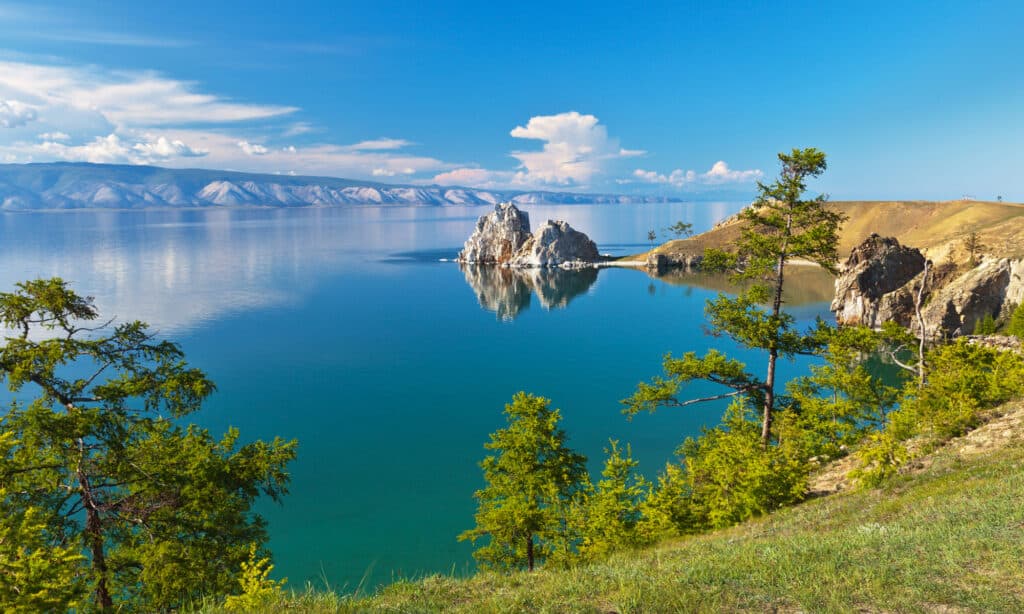
Lake Baikal’s waters have more than 50 fish species such as the omul and stone sculpin.
©Katvic/Shutterstock.com
Lake Baikal’s waters are rich with marine life. There are more than 50 fish species in its waters. Here are the fishes of Lake Baikal:
- Omul (Coregonus migratorius)
- Taimen (Hucho taimen)
- Lenok (Brachymystax)
- Davatchan (Salvelinus alpinus erythrinus)
- Sturgeon (Acipenseridae)
- Catfish (Siluriformes)
- Whitefish (Coregonus clupeaformis)
- Black grayling (Thymallus baicalensis)
- White grayling (Thymallus arcticus)
- Burbot (Lota lota)
- Bream (Abramis brama)
- Sazan (Cyprinus carpio)
- Tench (Tinca tinca)
- Roach (Rutilus rutilus)
- Redeye (Ambloplites rupestris)
- Crucian (Carassius carassius)
- Ides (Leuciscus idus)
- European Perch (Perca fluviatilis)
- Kessler’s Sculpin (Leocottus kesslerii)
- Northern Pike (Esox lucius)
- Stone Sculpin (Paracottus knerii)
- Baikal Yellowfin (Cottocomephorus grewingkii)
Amphibians of Lake Baikal
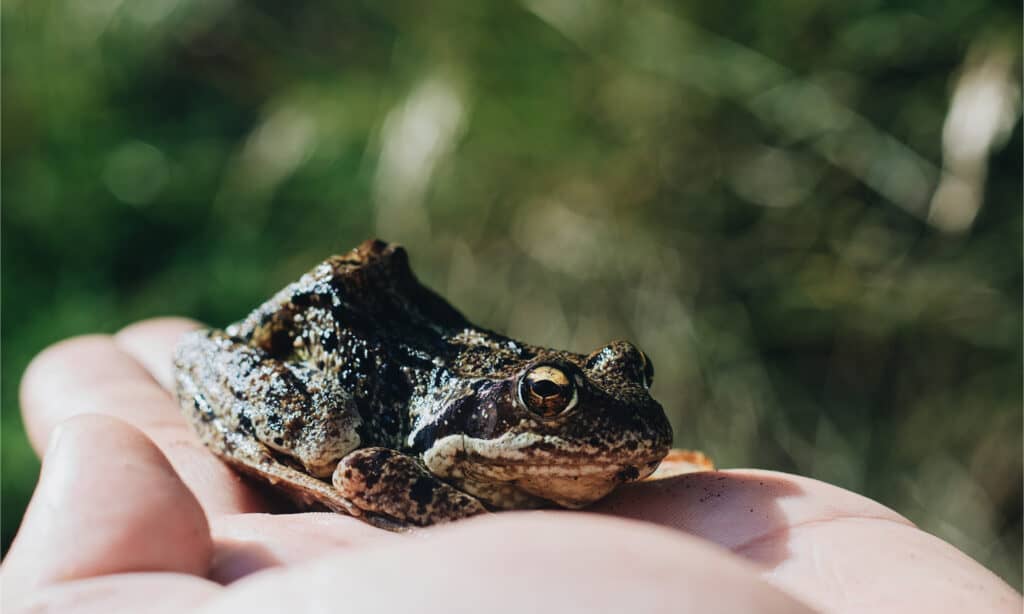
The Siberian wood frog is one of the most commonly spotted amphibians in Lake Baikal.
©Wirestock Creators/Shutterstock.com
Lake Baikal is home to various amphibians including its native Siberian wild frog.
- Moor Frog (Rana arvalis)
- Mongolian Toad (Strauchbufo raddei)
- Siberian Wood Frog (Rana amurensis)
Reptiles of Lake Baikal
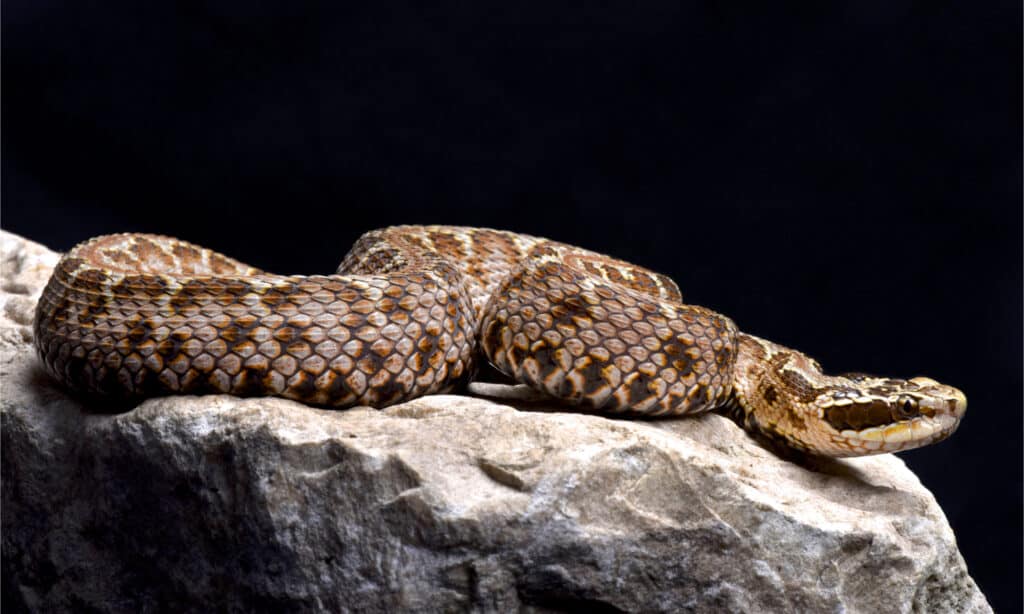
The Halys pit viper is Lake Baikal’s most venomous snake.
©reptiles4all/Shutterstock.com
Lake Baikal is home to various reptiles but most are harmless. The Halys pit viper is Lake Baikal’s most venomous snake.
- Grass Snake (Natrix natrix)
- Halys Pit Viper (Gloydius halys)
- Sand Lizard (Lacerta agilis)
- Steppe Ratsnake (Elaphe dione)
- Viviparous Lizard (Zootoca vivipara)
The photo featured at the top of this post is © Katvic/Shutterstock.com
Thank you for reading! Have some feedback for us? Contact the AZ Animals editorial team.






